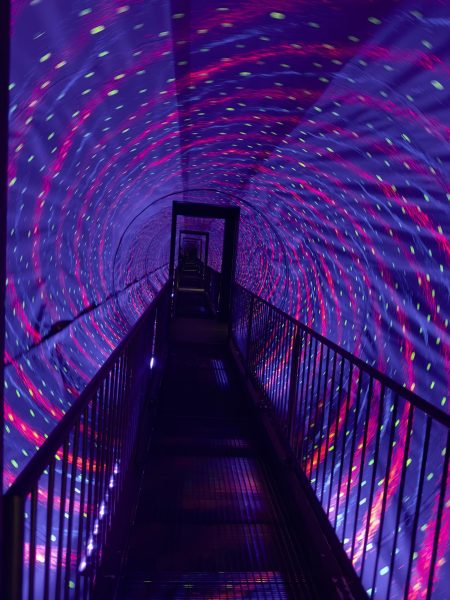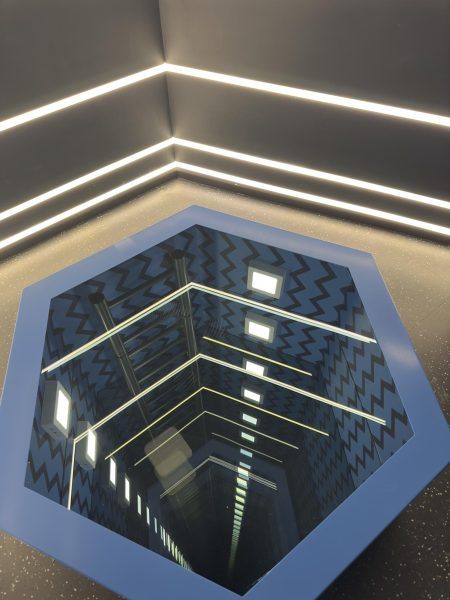Nestled in Faneuil Hall Marketplace is a brand new perception-altering experience. From the hypnotic lights to slanted floors, the Museum of Illusions, which opened Saturday, contains exhibits that disrupt the connection between seeing and believing.¬Ý
Several displays involve solid objects moving through distorted spaces, and although we can see them pass through, it‚Äôs impossible to understand how that happens.¬Ý
‚ÄúIt‚Äôs funny what your brain thinks is happening even though your eyes know what‚Äôs happening,‚Äù said Stacy Stec, director of sales and marketing.¬Ý
Play with reflection, mirrors, and illumination inside each room. With familiar, trippy wall art and science at its core, the Museum of Illusions is both an Instagrammable attraction and a learning opportunity.¬Ý
The words ‚ÄúEnter the Illusion‚Äù glow above the door frame leading into the museum exhibits, where Benjamin Franklin‚Äôs eyes follow museum-goers to the first room.¬Ý
The Ames Room, more affectionately known as the “big-little room,” gives the illusion of one person towering over the other by standing in spots where the floor is a different height. The effect makes it the perfect place for family photos and a fun photo opportunity for the bigs and littles in Emerson’s fraternities and sororities.
Stec said the Ames Room is just one of many “photo-worthy” spots in the museum where visitors can also snap photos where they appear to be hanging off the side of buildings, sitting on a gigantic chair, and have their head on a dinner platter.
Guests can walk through the museum‚Äôs light tunnel where pink, purple, and green lights spin on the walls. Although the walkway is not moving, many visitors, including myself, felt as if they were spinning and ended up walking into the railing. If the tunnel is too dizzying, guests can step out or hold onto both railings and stumble their way to the end.¬Ý¬Ý

However, the Museum of Illusions is ‚Äúnot just a place to pose for photos, but a place to learn about what you‚Äôre looking at,‚Äù said Stec.¬Ý
The Dark Gallery highlights how color and reflections can dramatically alter perceptions. The first exhibit in the Dark Gallery is the Infinity Room, which presents a hexagonal mirror for endless mirror selfies.¬Ý
Outside of that room is the Infinity Portal, a bottomless pothole illusion that guests can stand on and seemingly enter the portal with the tunnel extending above and below them. Although the portal is only two feet high, guests who are afraid of heights may not enjoy standing on it, according to Stec.¬Ý
The color rooms explore how red, blue, and green light come together to create white light. The RGB Room and the Color Room create colorful shadows and changing wallpaper designs where different patterns are revealed under a certain color of light.¬Ý
A giant dodecahedron rests in the middle of the hallway. When walking by, it appears that the infinite amount of sides create a never-ending tunnel. ‚ÄúCan I climb inside?‚Äù is a question kids often ask, according to Stec, but unfortunately for those kids, it is an entirely enclosed shape made of mirrors and lights.¬Ý¬Ý

The final exhibit in the museum is where visitors often spend hours, Stec said. The Puzzle Room includes gigantic versions of block puzzles and the Tower of Hanoi. The words ‚ÄúNothing is as it seems‚Äù are written on the wall next to the puzzle bar that overlooks Faneuil Hall.¬Ý¬Ý
The activities in the Puzzle Room and throughout the museum are best suited for teenagers, adults, and children over the age of eight. Although younger children may enjoy the museum, they don‚Äôt typically understand the illusions, said Stec.¬Ý
The museum welcomes field trip groups for children in grades three and above to actualize their science curriculums through the exploration of mirrors and reflections.
All the museum exhibits lead guests to the “Smart Shop” gift shop. Souvenirs range from miniature versions of the activities in the puzzle rooms to gigantic, bendy pencils.
In February, the WNDR Museum opened in Downtown Boston. With comparable ticket prices and bright displays, the museums may seem similar, but Stec said they focus on different things.¬Ý
She has visited both museum locations in Chicago and considers the WNDR museum to be “more art-focused,” while the Museum of Illusions focuses on “immersive psychological perception.”
The first Museum of Illusions opened in 2015 in Croatia to create permanent exhibits for cognitive sciences, according to Stec. Since then, the museum has opened over 50 franchise locations across 25 countries, making it ‚Äúthe largest and fastest-growing chain of private museums in the world,‚Äù according to its website. The Boston location is the first in New England and one of the largest locations with 10,000 square feet of space.¬Ý
The permanent exhibits will change every two to three years in an effort ‚Äúto bring locals back‚Äù to the museum, Stec said.¬Ý
The Museum of Illusions will be open seven days per week, including holidays, beginning Nov. 23. Tickets are $38 for adults and $33 for children over the age of five. Any advanced tickets purchased online before Friday, Nov. 22 will be 20% off.¬Ý
Seniors and veterans are eligible for discounts, and teachers receive free entries on Tuesdays with a valid ID. The museum also offers a $2 discount for college students who present a school ID in person.
College students can use the museum to ‚Äúescape reality,‚Äù especially during finals season, said Stec. She considers visiting the museum as an opportunity to take ‚Äúfunny photos‚Äù and to laugh with friends.¬Ý